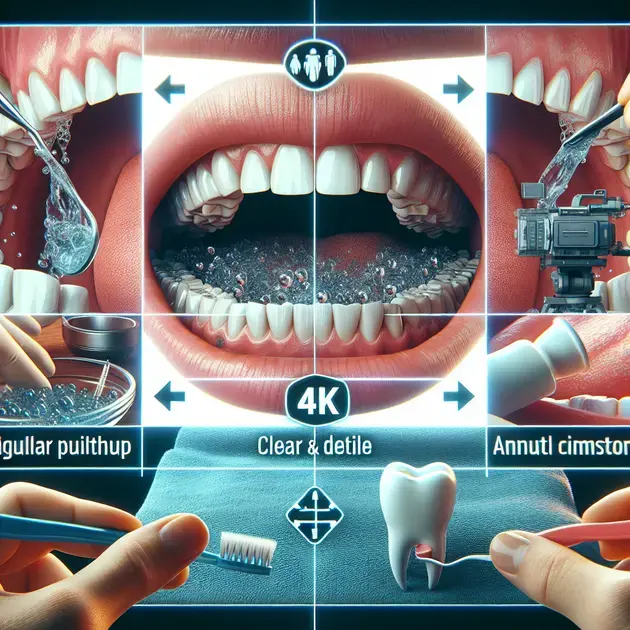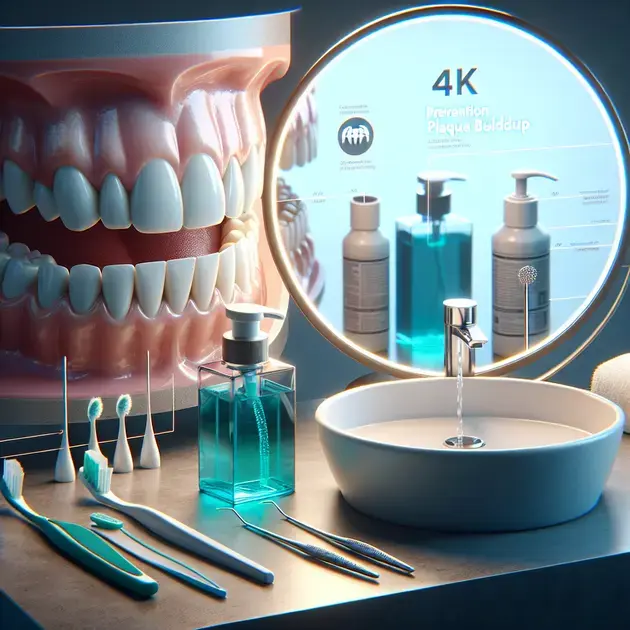Understanding the Link Between Plaque and Teeth is essential for maintaining good oral health. Plaque is a sticky film of bacteria that forms on teeth and can lead to various dental issues if not properly removed. By understanding how plaque affects our teeth, we can take the necessary steps to prevent its buildup and protect our oral hygiene.
Recent studies have shown a direct correlation between excessive plaque buildup and an increased risk of developing gum disease. This highlights the importance of daily brushing, flossing, and regular dental check-ups to keep plaque at bay. By educating ourselves on the link between plaque and teeth, we can empower ourselves to make informed decisions for a healthier smile.

**
The Impact of Plaque on Dental Health
**
**
Plaque is a sticky film of bacteria that constantly forms on our teeth. If not removed regularly, it can have a severe impact on our dental health. Plaque produces acids that can erode tooth enamel, leading to cavities. It can also cause gum inflammation, known as gingivitis, which if left untreated, can progress to periodontal disease. This can result in tooth loss and other serious health issues such as heart disease and diabetes.
**
**
To prevent the negative effects of plaque on dental health, it is crucial to establish a proper oral hygiene routine. Brushing your teeth at least twice a day with a fluoride toothpaste helps remove plaque from the surfaces of the teeth. Flossing daily is also essential to clean between the teeth and along the gumline, where toothbrushes may not reach. Regular dental check-ups and professional cleanings are vital to detect and remove any plaque buildup that cannot be addressed through at-home care alone.
**
**
One valuable resource to learn more about the impact of plaque on dental health is the American Dental Association (ADA) website. The ADA offers a wealth of information on oral health, including articles on plaque, its effects, and how to prevent and treat it. By visiting the ADA website, individuals can educate themselves on the importance of plaque removal and the potential consequences of neglecting oral hygiene.
**
**
Utilizing educational dental apps like BrushDJ can also be beneficial in understanding the impact of plaque on dental health. BrushDJ is an app that plays two minutes of music to encourage users to brush their teeth for the recommended time. It also provides reminders for when to replace toothbrushes and attend dental appointments. This interactive tool can help individuals stay motivated to maintain good oral hygiene practices and prevent plaque buildup.
**
**
In conclusion, being aware of the impact of plaque on dental health is essential for maintaining a healthy smile and overall well-being. By taking proactive steps to prevent plaque buildup through proper oral hygiene and seeking knowledge from reputable sources like the ADA and educational apps such as BrushDJ, individuals can empower themselves to protect their teeth and gums from the harmful effects of plaque.
**
**
Preventing Plaque Buildup through Proper Oral Hygiene
**
**
Effective oral hygiene practices are crucial in preventing plaque buildup and maintaining good dental health. By following a step-by-step routine, individuals can minimize the accumulation of plaque on their teeth and reduce the risk of dental issues. Here are some key steps to prevent plaque buildup through proper oral hygiene:
**
**
Step 1: Brushing Technique
**
**
Effective brushing technique is essential for removing plaque from the surfaces of the teeth. Use a soft-bristled toothbrush and fluoride toothpaste. Hold the brush at a 45-degree angle to the gums and brush in gentle circular motions. Be sure to brush all surfaces of the teeth, including the front, back, and chewing surfaces.
**
**
Step 2: Flossing Daily
**
**
Flossing is crucial for cleaning between the teeth and along the gumline, where plaque can accumulate. Use a piece of floss about 18 inches long and wrap it around your fingers. Gently guide the floss between each tooth, forming a C-shape around the tooth to remove plaque and debris. Repeat this process for each tooth, making sure to floss under the gumline.
**
**
Step 3: Using Mouthwash**
**
Antiseptic mouthwashes can help reduce plaque and gingivitis. Rinse with a therapeutic mouthwash that contains fluoride and antimicrobial ingredients after brushing and flossing. This can help kill bacteria in areas of the mouth that may be difficult to reach with a toothbrush or floss, contributing to plaque prevention.
**
**
One helpful tool for preventing plaque buildup is the Oral-B app, which provides personalized oral care guidance. The app offers brushing tips, reminders for dental appointments, and tracking of oral care habits. By incorporating the Oral-B app into your daily routine, you can receive expert recommendations to improve your oral hygiene practices and prevent plaque accumulation.
**
**
In conclusion, by following a thorough oral hygiene routine that includes proper brushing, flossing, and the use of mouthwash, individuals can effectively prevent plaque buildup and maintain a healthy smile. Utilizing resources like the Oral-B app can further enhance your oral care regimen and empower you with the knowledge and tools needed to combat plaque and protect your dental health.
**

**
The Importance of Regular Dental Checkups
**
Regular dental checkups are crucial for maintaining good oral health. By visiting your dentist on a consistent basis, you can prevent dental problems from developing or catch them early on before they worsen. During a dental checkup, your dentist will examine your teeth and gums, looking for any signs of decay, gum disease, or other issues. They will also perform a professional cleaning to remove plaque and tartar buildup, which can help prevent cavities and gum disease.
Furthermore, regular dental checkups allow your dentist to detect any potential issues that may not be visible to the naked eye. X-rays and other diagnostic tools can help identify problems such as impacted teeth, bone loss, and signs of oral cancer. Early detection is key in treating these conditions effectively and preventing further complications.
In addition to maintaining oral health, regular dental checkups can also have a positive impact on your overall health. Research has shown that there is a connection between oral health and systemic conditions such as heart disease, diabetes, and respiratory infections. By taking care of your teeth and gums through regular checkups, you are also taking care of your body and reducing the risk of developing these serious health issues.
To ensure that you are reaping the full benefits of regular dental checkups, it is important to follow your dentist’s recommendations for follow-up appointments and at-home oral care. By incorporating good oral hygiene practices into your daily routine and scheduling routine checkups, you can maintain a healthy smile for years to come.
Step-by-step guide:
1. Schedule regular dental checkups at least twice a year.
2. Follow your dentist’s recommendations for at-home oral care.
3. Be proactive about addressing any dental concerns or issues.
4. Stay informed about the connection between oral health and overall health.
5. Maintain a healthy lifestyle to support good oral health.
**
Healthy Diet Choices for Stronger Teeth
**
Adopting a healthy diet is essential for maintaining strong and healthy teeth. The foods and beverages you consume play a significant role in your oral health, influencing the strength of your teeth and the condition of your gums. A balanced diet rich in nutrients such as calcium, vitamin C, and phosphorus can help support healthy teeth and gums, while reducing the risk of cavities and other dental issues.
Including dairy products, leafy greens, and lean proteins in your diet can provide the essential nutrients needed for strong teeth and bones. Foods high in calcium, such as milk and cheese, can help remineralize enamel and strengthen teeth, while vitamin C-rich fruits and vegetables can promote gum health and reduce inflammation.
Avoiding sugary and acidic foods is also important for protecting your teeth from decay and erosion. Limiting the consumption of sugary snacks and beverages can help prevent cavities, while minimizing acidic foods and drinks can reduce the risk of enamel erosion. Opt for water as your primary beverage choice and brush your teeth after consuming acidic or sugary foods to mitigate their negative effects.
Incorporating crunchy fruits and vegetables into your diet can also help clean your teeth and stimulate saliva production, which is essential for maintaining a healthy mouth environment. Additionally, drinking green tea and chewing sugar-free gum can aid in reducing bacteria in the mouth and freshening breath.
Step-by-step guide:
1. Include calcium-rich foods in your diet, such as dairy products and leafy greens.
2. Consume vitamin C-rich fruits and vegetables for gum health.
3. Limit sugary and acidic foods to prevent tooth decay and erosion.
4. Drink plenty of water and chew sugar-free gum to maintain oral hygiene.
5. Maintain a balanced diet to support overall oral health.
**
Effective Ways to Remove Plaque at Home
**
Plaque is a sticky film of bacteria that forms on the teeth and gums, leading to tooth decay and gum disease if not properly removed. While professional cleanings are essential for removing stubborn plaque buildup, there are also effective ways to remove plaque at home to maintain good oral hygiene between dental visits.
Brushing your teeth twice a day with a fluoride toothpaste is the foundation of any good oral hygiene routine. Use a soft-bristled toothbrush and gentle, circular motions to clean all surfaces of your teeth, including the gumline. Flossing at least once a day is also crucial for removing plaque and food particles from between teeth, where toothbrush bristles cannot reach.
In addition to brushing and flossing, incorporating an antimicrobial mouthwash into your oral care routine can help reduce plaque and prevent gum disease. Look for a mouthwash that is approved by the American Dental Association (ADA) and contains ingredients such as fluoride and cetylpyridinium chloride to kill bacteria and freshen breath.
Using interdental cleaners, such as dental picks or water flossers, can also be effective in removing plaque from hard-to-reach areas between teeth. These tools can help dislodge plaque and debris, promoting better gum health and reducing the risk of cavities.
To supplement your oral hygiene routine, consider incorporating natural remedies such as oil pulling with coconut oil or using baking soda as a gentle abrasive to help remove plaque. However, these methods should not replace regular brushing, flossing, and professional cleanings as recommended by your dentist.
Step-by-step guide:
1. Brush your teeth twice a day with fluoride toothpaste.
2. Floss at least once a day to remove plaque between teeth.
3. Use an ADA-approved antimicrobial mouthwash to reduce plaque and freshen breath.
4. Consider using interdental cleaners to reach areas that are difficult to access with a toothbrush.
5. Explore natural remedies like oil pulling and baking soda as complements to your oral care routine.
**
Conclusion
**
Regular dental checkups are essential for maintaining optimal oral health and preventing dental issues from escalating. These routine visits allow dentists to identify problems early on, such as decay, gum disease, or even signs of cancer, ensuring timely treatment and reducing the risk of complications. Additionally, the connection between oral health and overall well-being highlights the significance of regular dental care in preventing systemic conditions like heart disease and diabetes.
Adopting a healthy diet that includes calcium-rich foods, vitamin C sources, and avoiding sugary or acidic substances is crucial for promoting strong teeth and gums. Incorporating crunchy fruits and vegetables can aid in cleaning teeth and stimulating saliva production, contributing to a healthy oral environment. Following a balanced diet and staying hydrated with water can further support overall oral health.
Effective plaque removal at home through daily brushing with fluoride toothpaste, regular flossing, and the use of antimicrobial mouthwash is vital for preventing plaque buildup and maintaining good oral hygiene. Introducing interdental cleaners and exploring natural remedies like oil pulling or baking soda can complement your oral care routine, but should not replace professional cleanings and regular checkups as advised by your dentist.